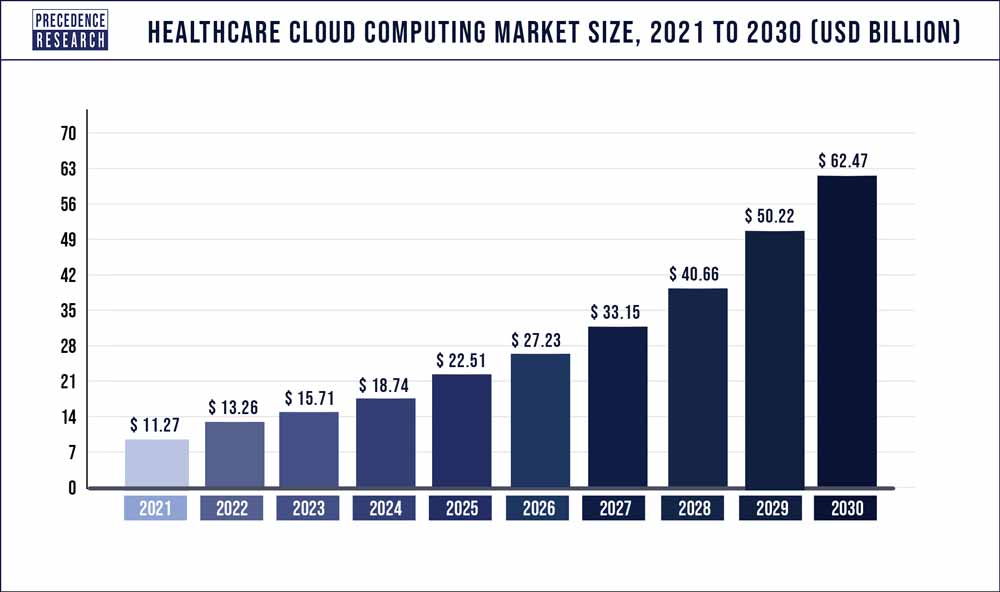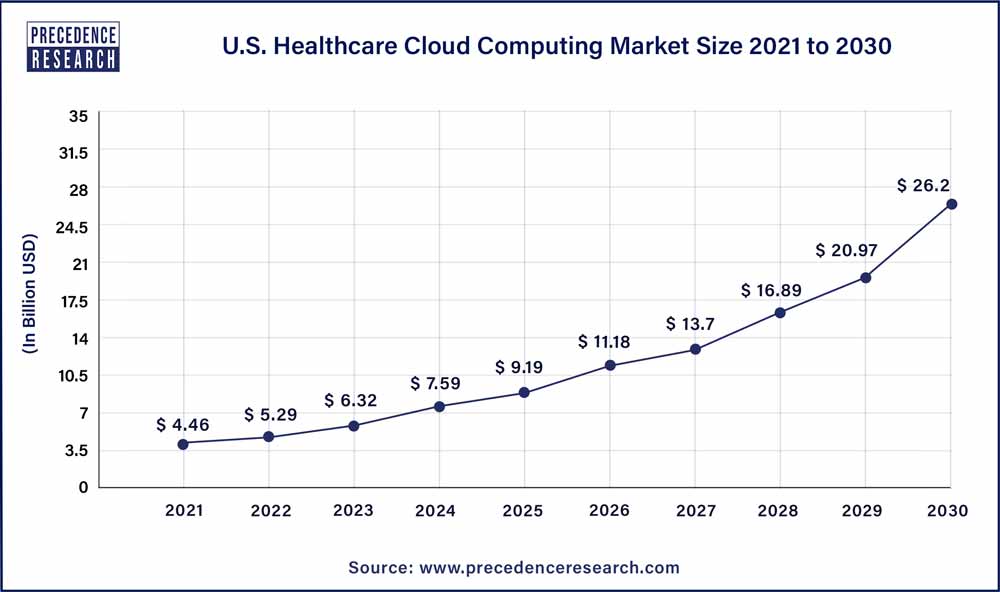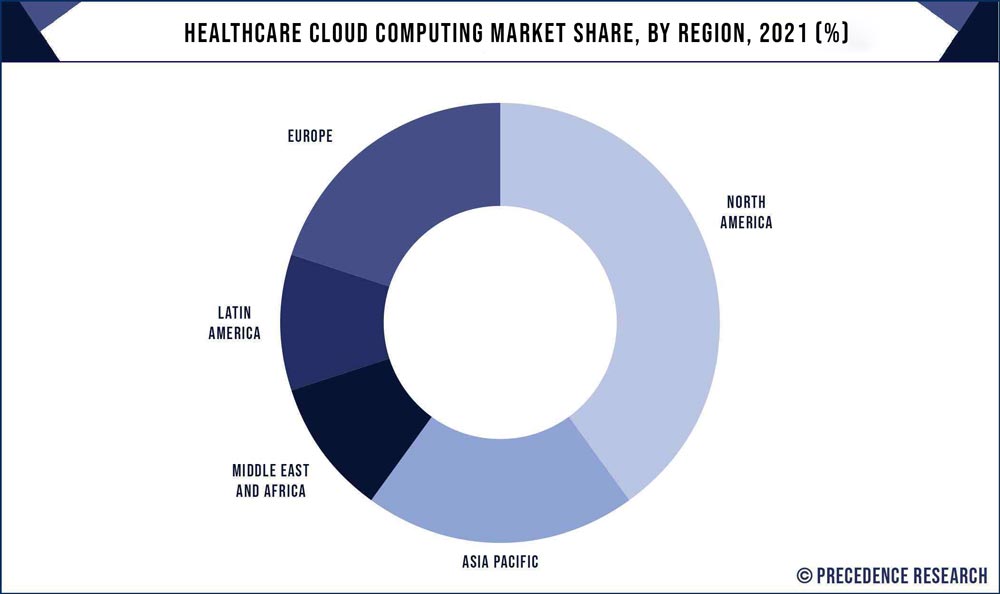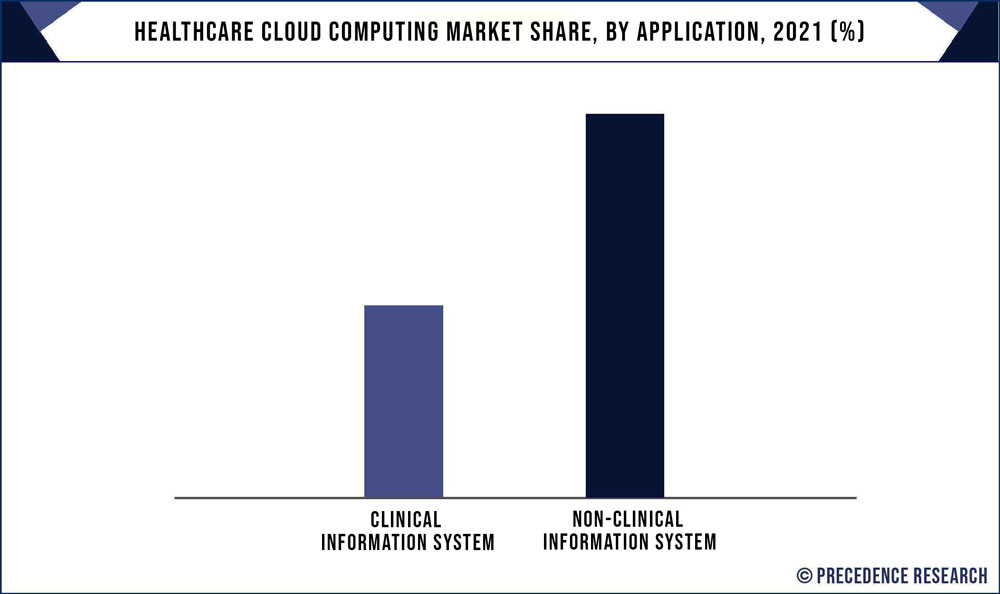The global healthcare cloud computing market size was valued at USD 61.78 billion in 2023 and is predicted to surpass around USD 244.80 billion by 2033 with a registered CAGR of around 14.76% during the forecast period 2024 to 2033.

Access our Healthcare Data Intelligence Tool with 10000+ Database, Visit: Towards Healthcare
The U.S. healthcare cloud computing market size accounted for USD 24.71 billion in 2023 and is estimated to reach around USD 101.38 billion by 2033, growing at a CAGR of 15.16% from 2024 to 2033.

Geographically, North America is embrace a prevalent marketstake in the healthcare cloud computing sector and is estimated to mirror analogous trend during years to come deprived of considerable fluctuations. U.S is a front-runner in the healthcare cloud computing arena, majorly on account of its high acceptance rate of healthcare IT services and unceasing support from the government organization.
North America is predicted to portray the largest market share in the projected period. Patients are encouraged to use the patient portal by their healthcare provider access and use the site more frequently than those least encouraged. An online gateway for patients provides quick, round-the-clock access to their personal health information from any location with a network connection. Patients can take charge of their health and care with the help of the patient portal. Patient portals can also assist care between visits, facilitate communication with the doctor, and save time. More patients than ever are using portals. For instance, around 77% of health executives are spending money on improved smartphone websites and applications. According to a survey by Intrado Healthcare on patient management trends for 2022, more than 50% intend to invest in systems to communicate with patients via messaging.
Furthermore, in Canada, the panorama of health insurance is evolving. The Canadian healthcare system would experience less strain as a result of the use of modern telehealth, which will also result in shorter wait times. The province-specific availability of several telehealth resources for Canadians varies. For instance, Telehealth Ontario offers anonymous, free medical guidance and data. Day or night, seven days a week, a healthcare professional would answer the phone.
Also, the region's ageing population, which is more likely to suffer chronic conditions including neurological diseases, hypertension, diabetes, and cardiovascular disease, is projected to raise demand for mobile health, which will help the market expand. For instance, the United Nations Population Fund's 2022 data show that 65% of Canada's population will be living in 2022 and primarily composed of people aged 15 to 64. Also, according to the same source, 19% of the population will be 65 or older in 2022.

On the other hand, healthcare cloud computing market in Europe is also expected to show robust growth throughout the prediction period. This is on account of growing awareness associated with obtainability of higher quality cloud computing solutions for healthcare. Besides, budding elderly population which is highly vulnerable to numerous diseases upsurges the amount of hospital admissions. All these aspects together are considered to have positive outlook on demand of healthcare cloud computing software in the Europe.
Several healthcare establishments can harness the advantages of the cloud more than ever due to recent technological advancement and augmented security. With the technological advancement such as remote monitoring, natural language processing APIs and telehealth cloud technology will endure to advance to fit novel digital health settings in multiple important means during years to come. As per Analytics Survey of HIMSS, more than 83% of healthcare organizations are now making use of cloud services.
Numerous healthcare facilities desire to take these cloud computing solutions to the next level by implementing groundbreaking technology. Instead of gathering and transferring data to the cloud, the system examines and works on it at the point of gathering. The propagation of high-speed internet and execution of promising controlling acts are also predictable to deliver growth prospects to the healthcare cloud computing market across the world. Yet, concerns connected to data portability obstacles, data privacy, and increasing number of cloud data breaches are curtailing the advancement of healthcare cloud computing market worldwide. Further, deficiency of accomplished IT professionals has decelerated implementation of this technology. Competent specialists are in great demand on account of the struggle in finding professionals with HIPAA expertise. This aptitude drought will expected to decelerate the shift to cloud computing systems.
| Report Highlights | Details |
| Growth Rate from 2024 to 2033 | CAGR of 14.76% |
| Market Size in 2023 | USD 61.78 Billion |
| Market Size by 2033 | USD 244.80 Billion |
| Largest Market | North America |
| Fastest Growing Market | Asia Pacific |
| Base Year | 2023 |
| Forecast Period | 2024 to 2033 |
| Segments Covered | Product, Cloud Deployment, Application, Service, End User, Region |
| Companies Mentioned | CareCloud Corporation, Athenahealth, Inc., Carestream Health, IBM Corporation, Dell Inc., Siemens Healthineers and Oracle Corporation |
Market Driver
A Rise in the Industry's Delivery of Emergency Medical Services:
There are various ways in which the pandemic has been unprecedented. To combat the pandemic and construct new facilities, set up a secure method of mass screening, or get the vaccine on the market, time was of the essence. It is possible to rely on cloud technology to accelerate the release of critical tech solutions in the industry.
For instance, Spoedtestcorona, a network of testing facilities offering Covid-19 quick diagnostic tests, had a hurdle when attempting to create a cross-platform web application on time while aiming to provide safe and inexpensive testing in the Netherlands and Belgium. The software was supposed to reduce face-to-face contact and make testing secure for patients and medical professionals.
By selecting Amazon Web Application services, they could meet both the stringent regulatory requirements involved with managing medical and personal data and execute the app in the record-breaking two-week time frame.
Market Restraints
Increasing Provider Lock-in:
Growing Possibility of Threat:
Market Opportunity
Cloud Computing's Expanding Use in Healthcare Provides Access to Big Data Applications:
There are greater prospects for big data applications to improve patient outcomes due to the expanding espousal of cloud-based data storehouse techniques in the healthcare industry. For instance, medical professionals in the US previously maintained patient records on paper. The amount of potentially valuable data in EMRs of the patient has always been enormous. This data could be utilized to forecast when a pandemic could start, find minute patterns in patient sicknesses that might indicate the disorder's origins, or determine which treatments were most successful for a particular symptomatic group.
All data previously locked away in filing storerooms can now be scoured via and analyzed by the most sophisticated computer algorithms owing to the use of cloud computing in hospitals and medical practices. Healthcare professionals will soon be able to identify and address hazards to the public's health that could previously go undetected until far in their life cycles.
Clinical information system segment involves telehealth solution, computerized physician order entry, population health management (PHM) solutions, electronic medical records, pharmacy information system, radiology information system, others.
Over the past two decades, clinical information systems (CIS) have proliferated and are currently present in every environment where healthcare is provided. CIS is everywhere, from modest facilities to major tertiary care facilities, pharmacies, and blood banks. These systems could be made up of standalone software programs or intricately interconnected modules that come together to form a more complicated approach. The software mainly provides a wide range of healthcare functions that once-simple medical devices are now minicomputers that must be connected to the more extensive electronic health record.
Since encrypted messaging has become a viable option for provider-patient communication, telehealth enables care delivery outside of an organization's physical boundaries. Health information exchanges allow communication between providers and organizations. Records use the patient information gathered to better track problems and the services provided for prevention and treatment. Due to the development of these systems, new developments are possible that will advance healthcare technology significantly.

Clinical information systems segment gathered sizable market share in terms of revenue in 2023 credited to snowballing demand for maintaining raw data produced from physicians and doctors. This information involves notes made by pharmacists, physicians, doctors and prescriptions. Meanwhile, massive clinical data is produced every year which creates radical need for laboratory information management and health information system. All these factors contribute toward the growth of this segment.
Healthcare Cloud Computing Market Value (USD Mn), By Application, 2020-2023
| By Application | 2020 | 2021 | 2022 | 2023 |
| Clinical Information System | 14,666.3 | 16,221.9 | 18,020.6 | 20,106.5 |
| Non-clinical Information System | 28,106.6 | 31,890.1 | 36,365.3 | 41,677.9 |
Healthcare cloud computing market is classified based upon the deployment into hybrid cloud, private cloud and public cloud. The private cloud segment accounted for the considerable revenue stake in 2023. This is due to need for storage of extremely sensitive patient data in a protected way to evade data privacy breach which might emerge legal ramifications.
A strategy that is gradually moving up in healthcare is the hybrid cloud. The hybrid cloud combines on-premises infrastructure with public and private cloud services, enabling businesses to shift workloads across virtual servers rapidly and safely to meet changing demands for IT resources.
The transition of healthcare organizations' IT assets to modern, adaptable infrastructures must be accelerated. By combining the advantages of public cloud and on-premises infrastructure, a hybrid cloud enables business apps and information to be more agile and scalable. All components of the healthcare ecosystem, including healthcare providers and payers, life sciences, and consumer health, can benefit from switching to a hybrid cloud architecture.
In addition, over the past five years, players in the healthcare and life sciences industries have adopted hybrid cloud or made substantial headway in doing so, and they're currently moving into the next stage with increased ambition, investments, and interest. For instance, In a recent IBM Global C-suite analysis, 82 % of healthcare and life sciences leaders identified as pioneers who mainly integrate data into their operations, strategies, and culture anticipated making sizable investment opportunities in the hybrid cloud.
Healthcare Cloud Computing Market Value (US$ Mn), By Deployment, 2020-2023
| By Deployment | 2020 | 2021 | 2022 | 2023 |
| Public | 14,514.3 | 16,095.4 | 17,923.8 | 20,044.0 |
| Private | 22,361.3 | 25,207.3 | 28,553.9 | 32,502.5 |
| Hybrid | 5,897.3 | 6,809.3 | 7,908.1 | 9,237.9 |
Different types of services assessed in this market study are infrastructure-as-a-service, software-as-a-service and platform-as-a-service. In 2023, the SaaS services of the market occupied leading revenue share on account of multiple benefits delivered by this model including safety, quicker deployment time, less total charge of ownership, and lower up-front capital expenditures.
Several SaaS products are self-learning and autonomous; fortunately, healthcare businesses and organizations are increasingly interested in AI. The most successful IT companies more than 81% of them have started working on AI technologies, which are transforming corporate operations, boosting productivity, and complementing human talents while automating monotonous chores.
Many healthcare organizations will work to improve their capacity to store, handle, analyze, and safeguard crucial healthcare data as they get more experience using a variety of cloud providers. As a result, such coherent techniques will spread more widely in place of employing different cloud providers for distinct applications or disaster recovery.
Recently, firms have been able to approach big data differently thanks to APIs like Google Health. Therefore, the number of companies utilizing cloud-based apps is anticipated to rise by 19.6%.
Healthcare Cloud Computing Market Value (US$ Mn), By Offering, 2020-2023
| By Offering | 2020 | 2021 | 2022 | 2023 |
| Services | 31,753.5 | 35,884.4 | 40,772.7 | 46,580.9 |
| Platform as a Service (Paas) | 9,504.2 | 10,622.9 | 11,928.0 | 13,455.4 |
| Infrastructure as a Service (Iaas) | 4,792.8 | 5,267.6 | 5,812.2 | 6,438.6 |
| Software as a Service (Saas) | 17,456.5 | 19,994.0 | 23,032.5 | 26,687.0 |
| Hardware | 11,019.5 | 12,227.6 | 13,613.2 | 15,203.5 |
The healthcare payers are predicted to experience sustainable growth in the projected period. Insurance firms, health plan sponsors (employers and unions), and third-party payers are all examples of healthcare payers. Payers are quickly implementing cloud computing solutions for fraud protection, insurance claim settlement, secure data collecting and storage, and risk assessment. Insurers have traditionally had difficulty managing high-risk patient populations and high use. To reduce the increase in healthcare costs, payers are implementing these cutting-edge technology systems and solutions. Cloud computing also enables payers to grow their businesses, raise reliability, lower administrative costs, and enhance services.
Alliances that distinguish, collect payments, service prices, manage claims, and pay provider claims, are known as payers in the healthcare sector. Instances of payers are Medicare, health program providers, and Medicaid. For instance, there are numerous payers across the market, With around 900 health insurance providers operating across the country. These companies supply 34.4% of public health care and 67.3% of private health care through their health plans.
Healthcare Cloud Computing Market Value (US$ Mn), By End User, 2020-2023
| By End User | 2020 | 2021 | 2022 | 2023 |
| Healthcare Providers | 23,525.2 | 26,700.7 | 30,467.0 | 34,951.5 |
| Healthcare Payers | 19,247.8 | 21,411.3 | 23,918.9 | 26,832.9 |
Rising public responsiveness and escalating need for rigorous regulatory compliance, upward venture from healthcare participants like GE Healthcare, IBM, Cisco, and government organizations are projected to generate a need for this system throughout the exploration period. Crucial industry performers have launched services and software that permits to collect and assimilate massive healthcare information that proves favorable for industry progression. Furthermore, such software also delivers stress-free access to patient information that aids healthcare professionals to takeprecise decisions. Along with the aforementioned drivers, high implementation rate of cloud computing software to advance hospital administration and empower fraud inhibitionis also creating optimistic avenue for the growth of healthcare cloud computing industry growth.
This research study comprises complete assessment of the market by means of far-reaching qualitative and quantitative perceptions, and predictions regarding the market. This report delivers classification of marketplace into impending and niche sectors. Further, this research study calculates market size and its development drift at global, regional, and country from 2020 to 2033. This report contains market breakdown and its revenue estimation by classifying it on the basis of end-use and region as follows:
By Product
By Deployment
By Application
By Service
By End Users
By Regional Outlook
PROCEED TO BUY :
ASK FOR SAMPLE
No cookie-cutter, only authentic analysis – take the 1st step to become a Precedence Research client